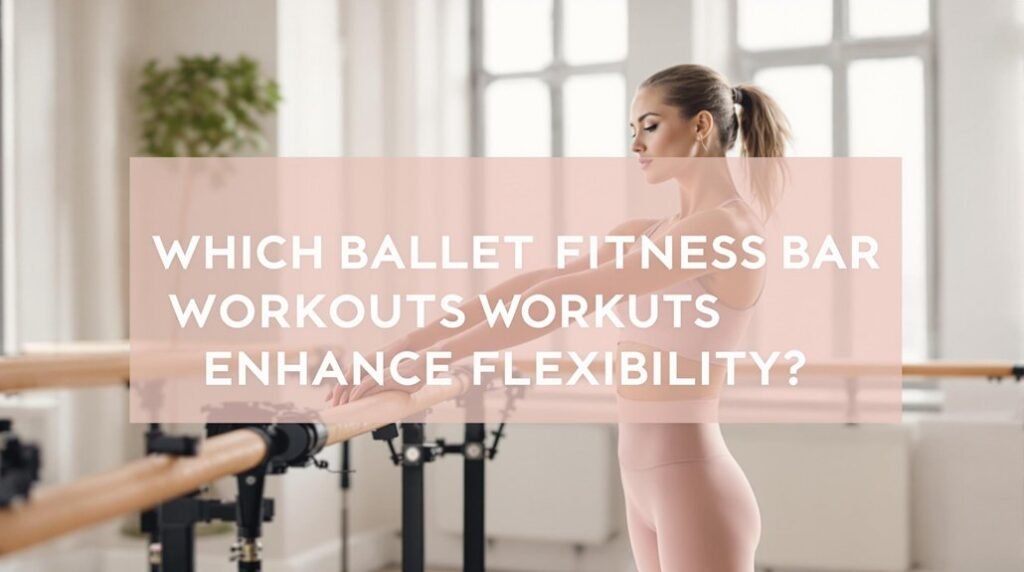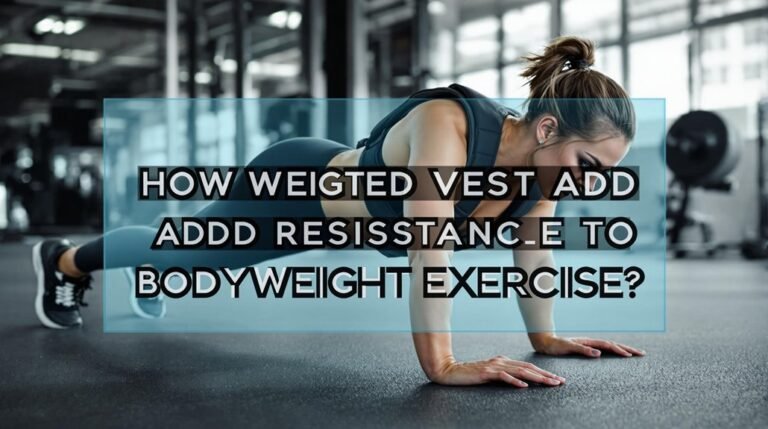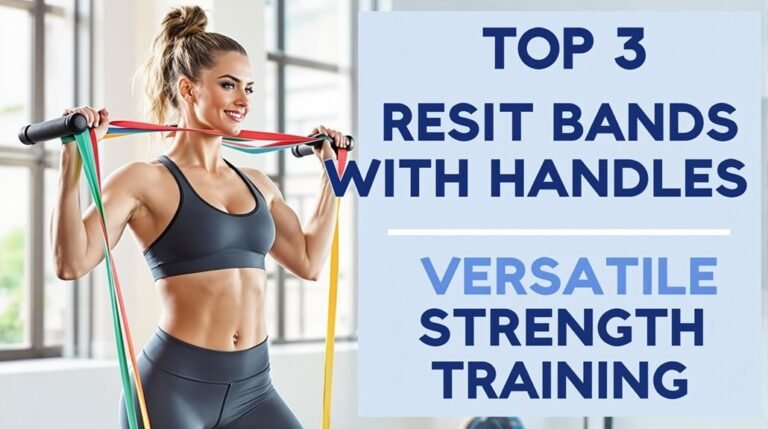You'll boost flexibility through several key ballet barre exercises that target specific muscle groups. Start with pliés to warm up and stretch your legs, then move into tendus for ankle mobility and leg extension. Dynamic stretches like rond de jambes enhance hip flexibility, while développés work on hamstring and hip flexor length. Core-focused movements like X Abs and V-Ups improve overall stability while increasing range of motion. Incorporate both static and dynamic stretching techniques, holding positions for 30 seconds when needed. These ballet-inspired movements, when practiced regularly with proper form, will release your body's full flexibility potential.
Key Takeaways
- Dynamic stretching combined with pliés and tendus improves muscle flexibility while strengthening legs and maintaining proper alignment.
- Rond de jambe exercises enhance hip mobility and leg flexibility through controlled circular movements at the barre.
- Developpé exercises target hip flexors and hamstrings, gradually increasing range of motion while building strength and control.
- Core flexibility workouts using X Abs and V-Ups develop deep abdominal muscles while improving overall stability.
- Interval-based training alternating between strength and stretching phases maximizes flexibility gains through active muscle engagement.
Understanding Ballet Barre Workouts
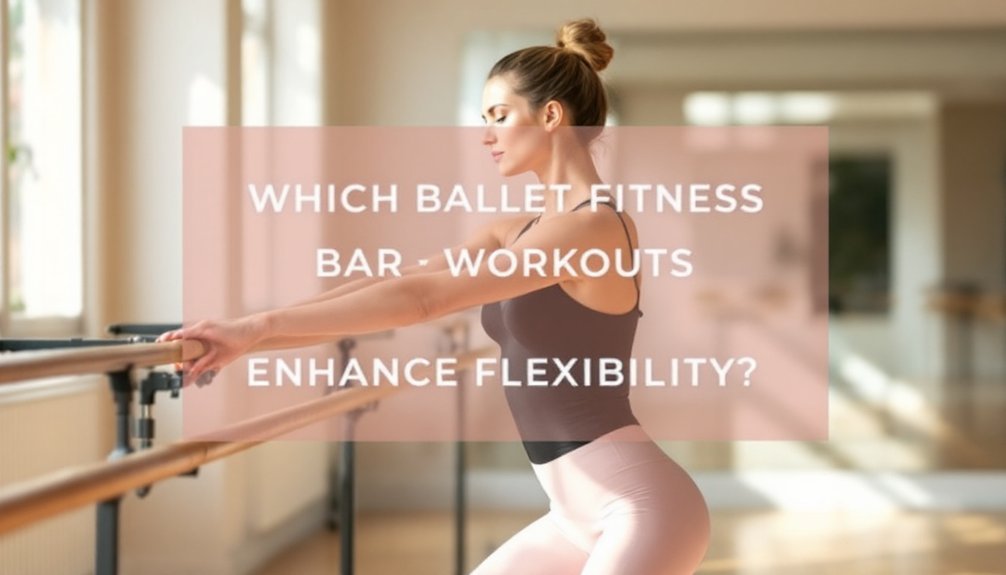
Ballet barre workouts combine traditional ballet movements with strength training and flexibility exercises to create a thorough fitness routine. When you're learning barre terminology, you'll encounter essential movements like pliés, which involve bending and stretching your knees, and tendus, where you slide your foot along the floor while maintaining contact. The sequence progresses from basic to advanced movements throughout each class.
There are several workout variations you can explore, depending on your fitness level and goals. The standard sequence begins with a warm-up at the barre, followed by fundamental exercises that focus on proper alignment and core engagement. You'll practice maintaining correct posture with your feet parallel, tailbone tucked, and heels together. As you progress, you can incorporate weights or modify movements to match your abilities while still focusing on precise, controlled movements and proper form. Additionally, incorporating high-performance fabrics in your workout attire can enhance comfort and support during these exercises.
Benefits of Barre Training
When you practice barre exercises regularly, you'll notice remarkable improvements in your muscle length and control, as the precise, ballet-inspired movements help lengthen and strengthen your muscles simultaneously. Your core muscles will become considerably stronger through the constant engagement required during barre movements, which includes proper spinal alignment and pelvic floor activation. The focus on proper body alignment makes barre an excellent choice for improving overall posture. As you progress in your training, you'll develop better balance and stability through the combination of standing exercises and controlled movements, all while maintaining proper form and posture. Additionally, the use of moisture-wicking fabrics in workout clothing can help keep you comfortable and focused during your barre sessions.
Muscle Length and Control
Through regular barre training, you'll experience remarkable improvements in muscle length and control, transforming how your body moves and stretches. Your muscle engagement increases through a combination of dynamic and static stretches, while isometric movements help target underutilized muscles for maximum flexibility improvement.
You'll see enhanced results through these key techniques:
- Dynamic-active stretches that generate heat, making muscles more pliable
- Isometric contractions that engage muscles without changing length
- Pulsing movements that activate and lengthen muscle fibers
- Small, controlled movements targeting specific muscle groups
The combination of ballet-inspired movements with Pilates and yoga principles creates an effective approach to developing longer, leaner muscles while improving your overall range of motion and body control. This low-impact workout method allows you to build flexibility without putting stress on your joints.
Core Strength Development
Building on your improved muscle control, core strength becomes a natural focus in barre training. Through exercises like Parallel Bent Knees and Flat Back Spine, you'll develop critical stability in your deep abdominal and pelvic floor muscles, which support your spine throughout daily activities.
Core engagement is central to every barre movement, targeting both superficial and deep muscles that traditional workouts often miss. You'll strengthen your entire core system through precise exercises like X Abs and V-Ups, while Side Bends specifically enhance your obliques and lateral stability. This thorough approach improves your posture and reduces back pain risk by activating the smaller stabilizing muscles around your spine. The controlled, low-impact nature of these movements guarantees you're building endurance without stressing your joints. These exercises are especially beneficial for those who sit for long hours, as they help counteract the effects of prolonged sitting on core muscles.
Essential Stretching Techniques
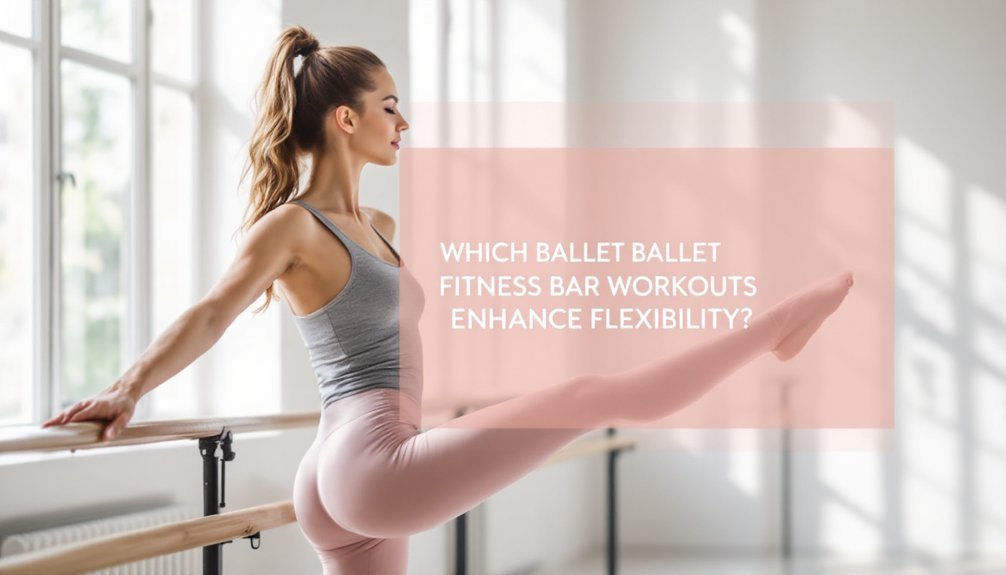
As you begin your barre workout, you'll need to master three fundamental stretching techniques that form the foundation of ballet flexibility training. Dynamic stretches, like controlled leg swings and arm circles, prepare your muscles through gentle, repetitive movements, while targeted muscle release work focuses on specific areas like your hip flexors and hamstrings through held positions. Deep extension methods, such as sustained splits and extended arabesques, help you achieve maximum range of motion by gradually increasing the intensity of each stretch while maintaining proper form and alignment. Incorporating warm up and band work for 10-15 minutes before these stretches helps prepare your muscles and nervous system for optimal performance. Additionally, ensuring that you have the right equipment can significantly enhance your stretching experience and results.
Dynamic Stretch Fundamentals
Dynamic stretching forms the foundation of an effective ballet fitness bar workout, combining fluid movements with purposeful stretches that prepare your body for exercise. Through dynamic warm ups and mobility drills, you'll enhance your body's readiness for the demanding movements of ballet-inspired workouts, while reducing your risk of injury. Walking knee to chest stretches target major muscle groups from your shoulders down to your thighs.
Here's what you'll achieve through proper dynamic stretching at the ballet bar:
- Increased blood flow to your muscles, preparing them for intense movement
- Enhanced joint mobility, particularly in your hips and shoulders
- Better nerve-to-muscle communication for improved control
- Greater range of motion through movement-based stretches
When performing these stretches, start with smaller movements and gradually increase your range of motion. Focus on fluid, controlled movements rather than holding static positions, mimicking the graceful nature of ballet exercises.
Targeted Muscle Release
Effective muscle release techniques form the cornerstone of ballet fitness bar training. Through targeted techniques, you'll optimize muscle flexibility while preventing injury during your workouts. Position your body precisely by adjusting foot width and rotating your femur to maximize each stretch's effectiveness.
For muscle optimization, incorporate both seated and standing variations at the barre. You'll want to use the bar for stability while performing diagonal movements and leg lifts, keeping your shoulders and hips aligned throughout. Practice lateral flexes while seated, and use standing lunges to target your legs and hips. Remember to maintain proper positioning until you feel the tissue release before progressing further. Using hands-on trigger points can help identify and release specific areas of tension. Combine these movements with controlled breathing to enhance your stretching routine's effectiveness.
Deep Extension Methods
When mastering ballet fitness bar workouts, deep extension methods form the foundation for developing exceptional flexibility and range of motion. By incorporating deep stretch techniques into your routine, you'll gradually improve your flexibility progression through focused, controlled movements. Regular practice helps achieve proper muscle recovery through consistent stretching routines.
- Start with developpé exercises, lifting your leg through passé position before extending it fully to the front and side
- Practice arabesque positions while maintaining proper alignment, focusing on back leg extension
- Perform deep lunges in your hip flexor stretches, holding each position for 30 seconds
- Incorporate single-leg RDLs to strengthen and lengthen your hamstrings simultaneously
These movements should be executed with careful attention to form, allowing you to safely increase your range of motion while building strength in extended positions. Remember to breathe deeply and maintain core engagement throughout each exercise.
Posture and Balance Elements
Proper posture and balance form the cornerstone of ballet fitness bar workouts, setting the foundation for every movement you'll perform. Through posture alignment techniques and core engagement, you'll learn to maintain a strong, stable spine while executing controlled movements at the barre.
You'll start with basic exercises like pliés and tendus to establish proper body positioning and balance techniques. The barre provides essential support as you work through leg stretches and circular movements, helping you develop ankle strength and core stability. Side stretches and lunges help activate your lateral muscles while improving flexibility. As you progress, you'll notice improvements in your muscle balance and overall flexibility. Additionally, incorporating specific footwear can enhance your performance and comfort during these workouts.
Core-focused exercises and slow, controlled movements will enhance your stability, while specific stretches target your legs, hips, and back. Remember to maintain controlled breathing throughout each exercise to maximize flexibility gains and reduce tension.
Dynamic Barre Movement Series
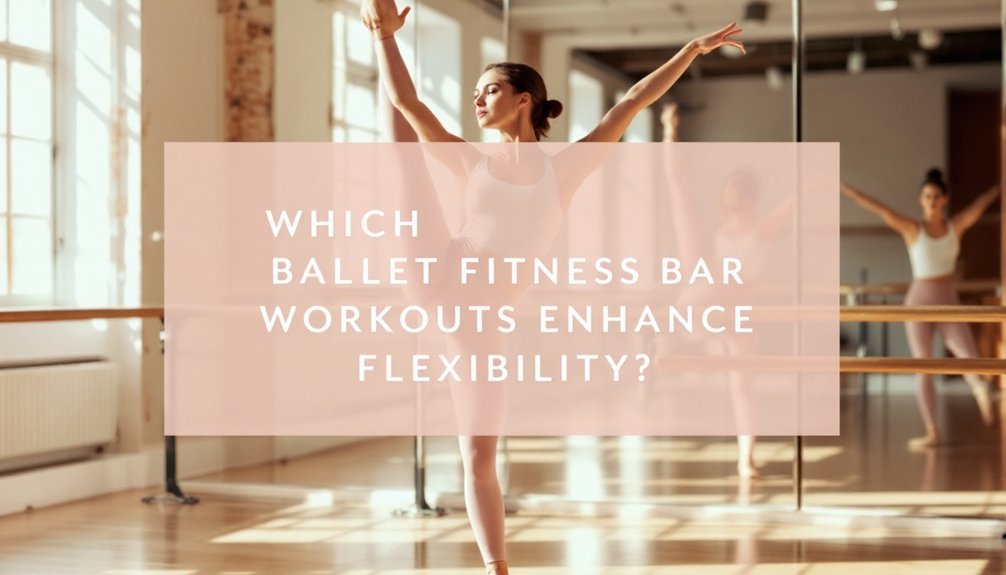
Dynamic barre movement series combine fluid motions with controlled resistance to maximize your flexibility gains. Through dynamic movement patterns and structured sequences, you'll enhance your range of motion while building strength and control. Regular participation in these workouts helps develop muscle endurance, enhancing both mobility and flexibility over time. Incorporating essential accessories like resistance bands and stability balls can further support your training.
Here's what makes barre techniques especially effective for flexibility:
- Circular movements like rond de jambes work multiple muscle groups simultaneously
- Active stretching engages opposing muscles for better functional mobility
- Full-range exercises guide joints through complete motion patterns
- Interval-based training alternates between strength and stretch phases
Your flexibility improvements come from the combination of precise control exercises, fluid movements, and targeted stretching sequences. These movements work together to create lasting flexibility gains while maintaining proper form and alignment through each exercise.
Building Core Flexibility
Building core flexibility through ballet-inspired barre exercises combines targeted movements with precise control to create a strong, supple midsection. You'll develop core stability through exercises like 90-degree toe taps, which engage both your upper and lower abs while working your obliques and hip flexors.
To enhance your flexibility techniques, incorporate side plank pulses and lowering leg beats into your routine. These movements challenge your core while strengthening your entire body. You'll want to complement these exercises with essential stretches, including the butterfly stretch for inner thighs and seated hamstring stretches for lower back flexibility. Remember to maintain proper form during classic barre movements like pliés and fondus, as they'll help you build the foundation for more advanced core work while improving your overall flexibility.
Safe Practice Guidelines
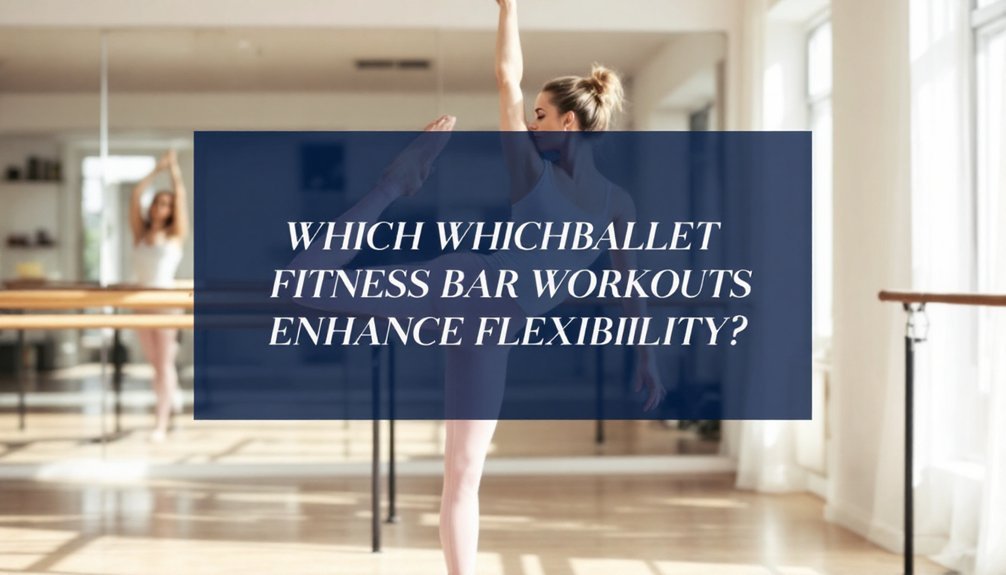
When approaching ballet barre workouts, you'll need to prioritize safe practice guidelines to prevent injury and maximize your flexibility gains. As part of your injury prevention strategy, always verify proper body alignment and warm up thoroughly before beginning any stretches.
Here are essential safety precautions you'll want to follow:
- Listen to your body's limits, stopping if you feel pain rather than just muscle engagement
- Maintain proper form throughout each movement, keeping your spine aligned and shoulders relaxed
- Progress gradually with your stretches, avoiding sudden increases in intensity or duration
- Use proper equipment, including a sturdy barre that's securely mounted at hip height
Remember to breathe deeply during your stretches, and don't force positions beyond your current flexibility level.
Progressive Flexibility Development
Now that you've mastered the safety basics, let's focus on developing your flexibility through Progressive Ballet Technique (PBT). You'll find that progressive techniques, combined with traditional barre work, create a thorough approach to flexibility progression. Using stability balls and resistance bands, PBT targets specific muscle groups while improving your overall body awareness.
| Exercise Type | Benefits | Equipment Needed |
|---|---|---|
| Core Work | Improved Control | Stability Ball |
| Adagio | Enhanced Extension | Barre |
| Rond de Jambe | Hip Flexibility | None |
| Frappé | Ankle Strength | Resistance Band |
| Petit Battement | Quick Precision | Barre |
Through consistent practice, you'll develop greater muscle memory and technical proficiency. PBT's adaptable nature means you can progress at your own pace, making it ideal for dancers at any skill level who want to improve their flexibility systematically.
Advanced Barre Flexibility Exercises
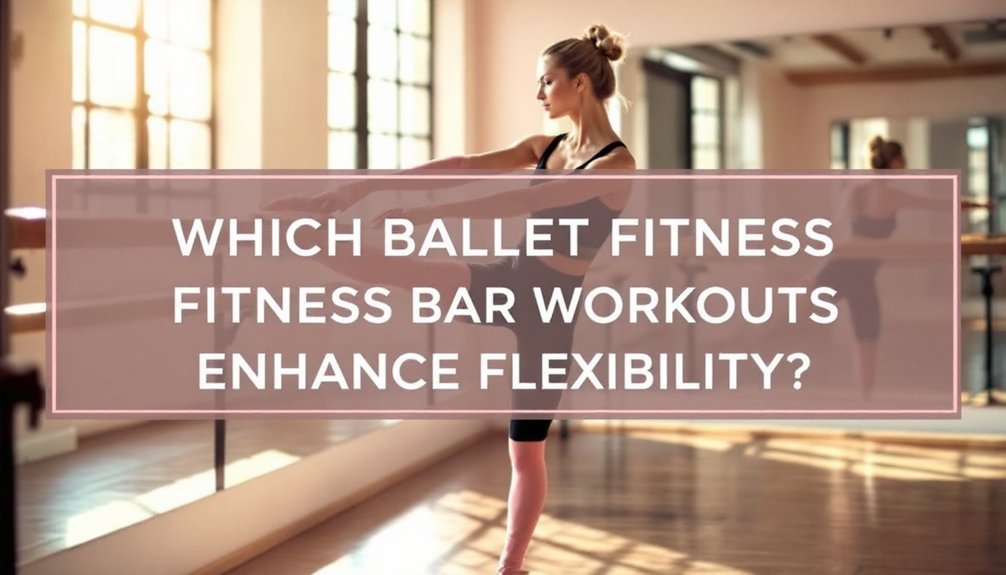
To advance your ballet flexibility journey, you'll need to master these targeted barre exercises that combine dynamic movement with controlled stretching. These advanced stretching techniques focus on developing both strength and flexibility through precise movements and sustained holds.
- Start with foundational plié stretches, engaging your core while pushing through the floor
- Progress to dynamic movements like frappes and dégagés to increase range of motion
- Incorporate specialized piriformis and hamstring stretches using the barre for support
- Practice combination stretches that work multiple muscle groups simultaneously
The flexibility techniques build upon each other, moving from basic positions to more complex movements. Your stretching routine should include both static holds and flowing movements, allowing your muscles to lengthen while maintaining proper alignment and control.
Frequently Asked Questions
How Long Does It Take to See Noticeable Improvements in Flexibility?
Put your heart and soul into consistent practice, and you'll reach flexibility milestones within 4-8 weeks. Your improvement timeline depends on workout frequency, intensity, and individual factors.
Can I Do Barre Workouts While Pregnant?
You can safely do barre during pregnancy with proper modifications. Prenatal barre classes offer tailored exercises, but always consult your healthcare provider and inform instructors about your pregnancy status.
What Should I Wear to a Barre Class?
Dressed to the nines for barre class attire, you'll want fitted leggings, a supportive sports bra, and a form-fitting tank top. Don't forget comfortable footwear like grippy socks.
Are Barre Workouts Suitable for People With Knee Problems?
Yes, you can safely do barre workouts with knee problems. There are modifications available for different exercises, and the low-impact nature helps with knee pain management when practiced correctly.
How Many Times per Week Should I Practice Barre for Flexibility?
You'll see ideal flexibility benefits by practicing barre 3-5 times per week. This workout frequency allows adequate muscle recovery while maintaining consistent progress in your flexibility development.

